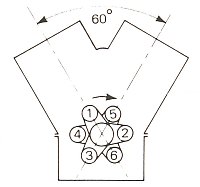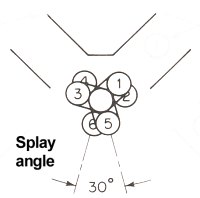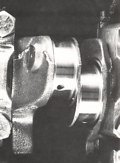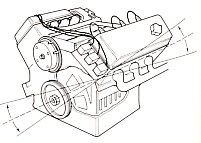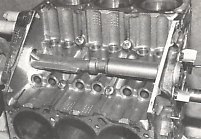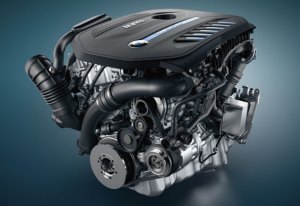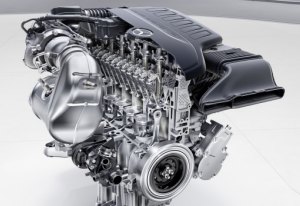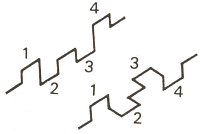|
AUTOZINE TECHNICAL SCHOOL
Engine Configuration and Smoothness Inline-6
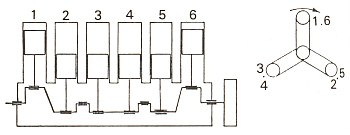 As shown in the picture, straight-6 engine is simply a pair of 3-cylinder engines mated together symmetrically, thus piston 1 is always in the same position as piston 6, piston 2 the same as piston 5... in other words, the engine is balanced end-to-end and requires no balancer shaft, unlike 3-cylinder engines. What about vertical and transverse forces? Like 3-cylinder engines, the vertical and transverse forces generated by individual cylinders, no matter first order or second order, are completely balanced by one another. The resultant vibration is nearly zero, thus inline-6 is virtually a perfect configuration. Inline-6 is not the only configuration delivering near perfect refinement, but it is the most compact among them. All boxer engines are perfectly balanced, but they are too wide and require double the number of blocks, heads and valvetrains. V12 engines also achieve perfect balance, but they are obviously out of the reach of most mass production cars. Automotive engineers knew that long ago, and that is why you can see most of the best classic engines were inline-6s, such as those used by Rolls-Royce Silver Ghost, Bentley Speed Six, Mercedes SSK, Jaguar XK-series, many Bugattis and BMWs. V6 V6 engines, excluding Volkswagen’s narrow-angle VR6 (to be discussed later), are not just made by splitting inline-6 into two banks arranged in V-shape. A V6 has a very different crankshaft - with only 4 main bearings instead of 7. In other words, between two adjacent bearings there are crank throws for 2 cylinders, one from bank A and another from bank B. While V8 engines have those 2 cylinders shared the same crank pin, V6 engine has to split the crank pin into two pieces, with a splay angle between those pins (30° splay angle for a 90° V6, or 60° splay angle for a 60° V6). These are illustrated below.
For better balance, most V6s separate the two banks of cylinders by either 60° or 90°. In this way, the movement of cylinders in bank A matches those in bank B, thus there is no vibration generated between banks. Besides, like 3-cylinder engines, there is no vertical and transverse vibration. However, both 60° or 90° V6s have somewhat end-to-end vibration like 3-cylinder engines, especially 90° V6. It needs a counter-rotating balancer shaft spinning at crank speed to suppress the vibration. The balancer shaft is normally recessed in the V-valley, so it does not occupy extra space. On the other hand, 90° V6 has a decisive advantage from production point of view - it can be machined in the production line of V8 because both of them are 90°. This saves a lot of production costs. An example is the Mercedes V6s used from the late 1990s, which shared the same architecture with the company's V8s but added with a balancer shaft.
60° V6 is smoother to the extent that, with adequate engine mounts, it could be made nearly as smooth as inline-6 engines without the need of balancer shaft. It is also narrower, thus easier to be packaged into FWD cars. 60° V6 versus Inline-6 As space efficiency becomes more and more important on modern cars, most manufacturers prefer V6 to inline-6. The most influential V6 was perhaps Alfa Romeo’s 2.5-litre 60° V6 used in the GTV6. It established a strong reputation that V6 can be compact, powerful and smooth. An equivalent inline-6 would not have been able to be fitted into the tight engine compartment of that car. Compare the shape of BMW with the Alfa and you will know the packaging advantage of V6s. Straight-six engines are nearly impossible to be used in front-wheel drive cars as well. As large as Volvo S80, it had to introduce the world’s shortest gearbox in order to make space for the 2.9-litre straight-six mounted transversely in the engine compartment. Longitudinal-mounted inline-6 does not have such problems, but it occupies too much length thus eats into cabin space. However, BMW is still persistant in using inline-6. Inline-6 engine is not only smoother but also more energy efficient since it has half the number of camshafts, cam drives and variable cam phasers compared with V6. With only one cylinder bank and one cylinder head, it is also quicker to warm up, thus is easier to meet cold-start emission requirements. Besides, the fewer components lead to lower production costs, even though it employs 3 more main bearings.
Moreover, inline-6 can be built as a modular family together with inline-4 or even inline-3 to slash production costs further. For example, BMW's B58 inline-6, B48 inline-4 and B38 inline-3 share the same architecture with 82 mm bore and 94.6 mm stroke, so they could be machined from the same toolings as well as easily fitted with the same components like Double Vanos and Valvetronic. This saves a lot of production and development costs. The inline-six/four modular family concept also attracted Mercedes to resurrect its traditional straight-six engine, which has been abandoned in the past 20 years. Under the trend of engine downsizing, Mercedes' V8 becomes a niche offering thus it would be wiser to group the six-cylinder into the four-cylinder family to enhance economy of scale. Inline-6 is on the way back. V8 Nearly all production V8s are 90°. There are very few exceptions, such as the 60-degree 3.4-litre V8 of Ford Taurus SHO (which was derived from Ford's 2.5-litre 60-degree V6) and TVR's 75-degree AJP8, but they do not achieve good balance like 90° V8s. Not all 90-degree V8s have the same crankshaft configuration. Most of them employ "cross-plane" crankshaft, including most American V8s and all luxury car V8s. Some exotic sports cars, such as Ferrari V8 series, Lotus Espirt V8, McLaren's V8, Porsche 918 Spyder and Ford Mustang GT350, employ "flat-plane" crankshaft.
No matter which kinds, they have 5 main bearings. A cylinder in bank A shares the same crank pin with the corresponding cylinder in bank B, therefore the crankshaft of V8 is actually simpler than that of V6. Both V8s generate no vibration in vertical and transverse directions or between bank and bank. Cross-plane V8 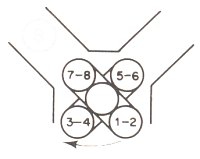 However, for cross-plane V8s, there is
vibration from end to end of the engine. This is because the first
piston of bank A is not in the same position as the last piston of bank
A (the same goes for bank B), unlike the case of an inline-4. However, for cross-plane V8s, there is
vibration from end to end of the engine. This is because the first
piston of bank A is not in the same position as the last piston of bank
A (the same goes for bank B), unlike the case of an inline-4. Never mind, the 90° V8 has this problem resolved by using a heavy counter weight at each cylinder. The counter weight is heavy enough to balance the weight of crank throw, con-rod and piston of that cylinder, thus cancelling all vibrations. 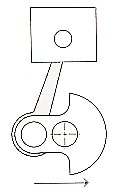 Now you must be wondering
why such counter weight is not used in other engine configurations. It
is because this counter weight must be used in
90° V-type engines with shared crank pins. From our previous
study, you can see only V8 fulfills all these requirements. Why are
there such requirements? Good question. As you know, all engines have
counter weights just enough to balance the weight of crank throws and
part of the connecting rods, leaving the remaining weight of connecting
rods and the whole, all-important pistons unbalanced. This is because
the rotating counter weight can balance only rotating mass. Unfortunately,
the piston moves vertically rather than rotates about the
crankshaft. To a large extent the connecting rod is also the same (its
center of gravity moves in elliptic path). If we insist to use heavy
counter weight,
it will cause side -to-side shake. Now you must be wondering
why such counter weight is not used in other engine configurations. It
is because this counter weight must be used in
90° V-type engines with shared crank pins. From our previous
study, you can see only V8 fulfills all these requirements. Why are
there such requirements? Good question. As you know, all engines have
counter weights just enough to balance the weight of crank throws and
part of the connecting rods, leaving the remaining weight of connecting
rods and the whole, all-important pistons unbalanced. This is because
the rotating counter weight can balance only rotating mass. Unfortunately,
the piston moves vertically rather than rotates about the
crankshaft. To a large extent the connecting rod is also the same (its
center of gravity moves in elliptic path). If we insist to use heavy
counter weight,
it will cause side -to-side shake.Considering the illustration on right hand side, assuming the counter weight in vertical position is heavy enough to balance the crank throw, con-rod and piston. When the crankshaft rotates 90° counter-clockwise, the counter weight is repositioned to the right, but the piston doesn’t go to the left, and the con-rod just partially moves to the left. Only the crank pin moves completely to the left. Now you can see the system is not balanced. The counter weight will generate a net force towards the right. However, for a 90° V8, when such a heavy counter weight moves to the right, the piston from another bank will cancel it completely, because their movement are exactly opposed at this moment. (see illustrations below) The same result can be found for the counter weight moving to the left. Therefore, 90° cross-plane V8 employing full-weight counter weights can achieve near perfect smoothness. 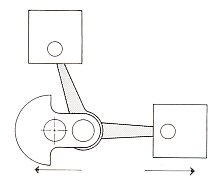 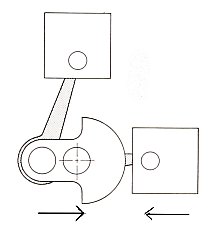 Flat-plane V8 However, the downside of cross-plane V8s is also caused by their heavy counter weights - not only increase the weight of the engine, they also contribute to rotational inertia, thus making the engine less responsive and less willing to rev. This could lower rev limit and reduce top-end power output. Moreover, the larger counter weights usually call for a larger crankcase to accommodate, thus lifting the height, hence center of gravity, of the enigne. Therefore the aformentioned high-performance V8s employ flat-plane crankshaft instead. 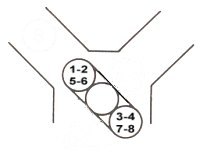 Flat-plane V8 is named according to the
shape of the crankshaft, which is in a flat plane. It is very much like
two inline-4 engines mated together. In particular, it achieves
end-to-end balance because the first piston and last piston of a bank
is exactly in the same position, so are the center two pistons. This is
just the same as straight-four engines, therefore the sound of
flat-plane V8 is also somewhat like a pair of four-cylinder engines
screaming simultaneously, unlike the rumble-bumble of cross-plane V8s. Flat-plane V8 is named according to the
shape of the crankshaft, which is in a flat plane. It is very much like
two inline-4 engines mated together. In particular, it achieves
end-to-end balance because the first piston and last piston of a bank
is exactly in the same position, so are the center two pistons. This is
just the same as straight-four engines, therefore the sound of
flat-plane V8 is also somewhat like a pair of four-cylinder engines
screaming simultaneously, unlike the rumble-bumble of cross-plane V8s.As both banks run like an inline-4 engine, there is second-order vibration. For a 90° flat-plane V8, the sum of second-order force generated in the 2 banks is - by simple vector analysis - 1.41 times (root-2) of the force generated by each of the inline-4 it consists of. And the direction of vibration is left-right instead of top-down. In other words, while displacement increases 100% compare with the inline-4, the second-order vibration increases just 41%. That makes the flat-plane V8 more refined than an inline-4 although it is not as smooth and quiet as cross-plane V8. To exotic sports cars, less refinement is not a big problem. Especially they usually employ shorter stroke and lightweight pistons and con-rods, the second-order vibration is greatly reduced. V10 Theoretically, the best V-angle is 72°. Like two inline-5 mated together, there is no vibration in vertical and transverse directions, but there is vibration from end to end of the engine, thus require a balancer shaft install in the V-valley for best balance. However, there is no vibration between bank and bank because pistons in both banks are in the same positions. Since V10 is not quite as smooth as V12 nor as compact as V8, not many manufacturers have ever built one - Chrysler (Viper), Porsche (Carrera GT), BMW (M5/M6), Audi (5.0 and 5.2 V10 for its own cars and baby Lambo), Volkswagen (5.0TDi) and Toyota (Lexus LFA). Apart from Lamborghini, none of them still employ this engine configuration today. V12 Theoretically the best balanced configuration for practical use. It is simply a duplication of inline-6 (therefore achieving the same perfect balance), with corresponding cylinders in both banks joined at the common crank pins. V12 is better than inline-6 just because it has more cylinders, thus doubling the firing frequency and smoothening the power delivery. No wonder V12 was widely used as aircraft engines during the two World Wars. Of course, the disadvantages are extra cost, size and weight. To enable even firing, most V12s employ 60° angle. 120° and 180° also enable even firing, but they would make the engine too wide to be installed. Ferrari did employ 180° V12s on its 365/512BB and Testarossa, which were usually confused as horizontally-opposed engines. However, traditionally Ferrari V12s employ 65° and a slightly uneven firing sequence which gives them a distinctive aural character. |
|||||||||||
 |
|||||||||||
| Copyright© 1997-2017 by Mark Wan @ AutoZine |
